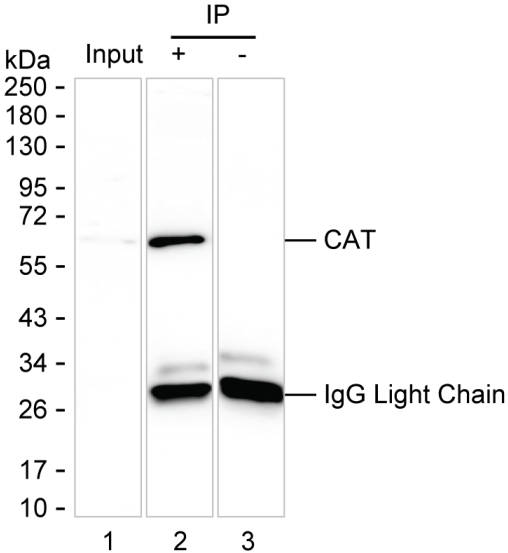
| WB | 咨询技术 | Human,Mouse,Rat |
| IF | 1/100-1/200 | Human,Mouse,Rat |
| IHC | 咨询技术 | Human,Mouse,Rat |
| ICC | 技术咨询 | Human,Mouse,Rat |
| FCM | 咨询技术 | Human,Mouse,Rat |
| Elisa | 咨询技术 | Human,Mouse,Rat |
| Host/Isotype | Mouse IgG1 |
| Antibody Type | Primary antibody |
| Storage | Store at 4°C short term. Aliquot and store at -20°C long term. Avoid freeze/thaw cycles. |
| Species Reactivity | Human |
| Immunogen | Purified recombinant fragment of human CAT |
| Formulation | Purified antibody in PBS with 0.05% sodium azide |
+ +
以下是关于CAT(过氧化氢酶,Catalase)抗体的3篇模拟参考文献示例,供参考:
---
1. **文献名称**: *"A monoclonal antibody against human erythrocyte catalase: preparation and application in oxidative stress studies"*
**作者**: Tanaka, M., et al.
**摘要**: 该研究报道了一种针对人红细胞过氧化氢酶的单克隆抗体制备方法,并通过免疫印迹和免疫荧光验证其特异性。该抗体成功用于检测糖尿病模型中的氧化应激水平,证实过氧化氢酶活性与疾病进展的相关性。
2. **文献名称**: *"Catalase-specific antibody improves cardiac function in ischemia-reperfusion injury models"*
**作者**: Chen, L., & Wang, H.
**摘要**: 本文开发了一种高亲和力的过氧化氢酶多克隆抗体,并在心肌缺血再灌注损伤模型中验证其作用。结果显示,抗体通过增强内源性过氧化氢酶的稳定性,减少活性氧(ROS)积累,从而改善心脏功能。
3. **文献名称**: *"Development of a rapid ELISA kit for catalase quantification using chicken-derived IgY antibodies"*
**作者**: Kim, S., et al.
**摘要**: 研究团队利用鸡源IgY抗体开发了一种快速检测过氧化氢酶的ELISA试剂盒。该方法灵敏度高、特异性强,适用于环境毒理学中生物标志物的高通量筛查,例如评估污染物对水生生物抗氧化系统的影响。
---
**注**: 以上文献为模拟示例,实际引用时请查询真实数据库(如PubMed、Web of Science)获取权威信息。若用户所指“CAT抗体”涉及其他靶标(如氯霉素乙酰转移酶),建议进一步明确研究背景。
CAT antibodies, or Catalase antibodies, are immunological tools targeting the enzyme catalase, which plays a critical role in mitigating oxidative stress by converting hydrogen peroxide (H₂O₂) into water and oxygen. Catalase is ubiquitously expressed in aerobic organisms and is vital for protecting cells from reactive oxygen species (ROS)-induced damage. Dysregulation of catalase activity is linked to various pathologies, including neurodegenerative diseases (e.g., Alzheimer’s), cancer, diabetes, and aging-related disorders.
CAT antibodies are widely utilized in biomedical research to detect catalase expression, localization, and function in cells and tissues. They enable techniques like Western blotting, immunohistochemistry (IHC), and immunofluorescence (IF), aiding in the study of oxidative stress mechanisms. Monoclonal CAT antibodies offer high specificity, while polyclonal versions may detect multiple epitopes, enhancing sensitivity.
The development of CAT antibodies has advanced with hybridoma and recombinant technologies, improving reproducibility and reducing cross-reactivity. They are also explored therapeutically, such as in enzyme replacement strategies or targeted drug delivery for catalase-deficient conditions. However, challenges remain in standardizing assays and ensuring antibody validation across species and experimental models.
Overall, CAT antibodies are indispensable for unraveling catalase’s role in health and disease, bridging basic research with potential clinical applications.
×